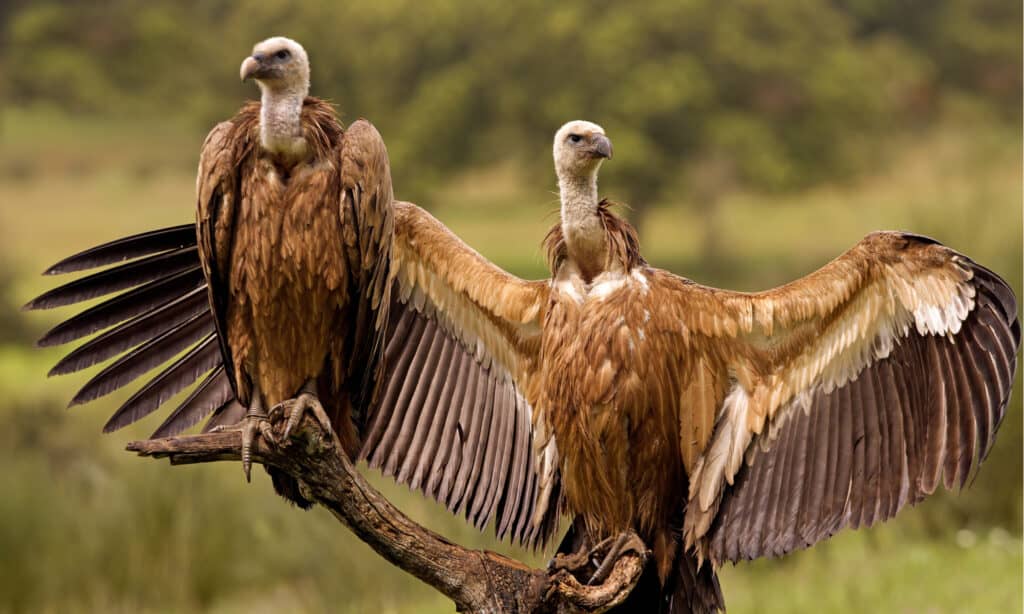Griffon Vulture
Gyps fulvus
Can spot a dead animal from thousands of feet away
Advertisement
Griffon Vulture Scientific Classification
- Kingdom
- Animalia
- Phylum
- Chordata
- Class
- Aves
- Order
- Accipitriformes
- Family
- Accipitridae
- Genus
- Gyps
- Scientific Name
- Gyps fulvus
Read our Complete Guide to Classification of Animals.
Griffon Vulture Conservation Status
Griffon Vulture Facts
- Prey
- Sheep, cows, other mammals
- Fun Fact
- Can spot a dead animal from thousands of feet away
- Estimated Population Size
- 80,000-900,000
- Biggest Threat
- Poisoning of livestock
- Most Distinctive Feature
- Finger-shaped feathers
- Other Name(s)
- Eurasian griffon
- Wingspan
- 8-9 feet
- Incubation Period
- 55 days
- Litter Size
- 1
- Habitat
- Mountains, shrublands, cliffs
- Predators
- Humans
- Diet
- Carnivore
- Type
- Bird
- Common Name
- Griffon vulture
- Number Of Species
- 3
- Location
- Africa, Asia, Europe
- Average Clutch Size
- 1
- Nesting Location
- Cliff areas
- Age of Molting
- 3.5 months
- Migratory
- 1
View all of the Griffon Vulture images!
“The Griffon Vulture can see carrion from thousands of feet above the ground”
Its eight-to-nine-foot wingspan is just one of the many impressive facts about a griffon vulture. They are found in Europe, Africa, and parts of Asia. These birds are carnivores eating carrion. Griffon vultures build their nests on cliff ledges. It can live 37 years and sometimes longer.
3 Griffon Vulture Amazing Facts
- The Ruppell’s griffon vulture is Critically Endangered.
- They fly at an altitude of 4,900 and 11,500 feet.
- These social birds live in vulture colonies.
Where to Find the Griffon Vulture
A Eurasian griffon vulture can be found throughout Spain, Saudi Arabia, and Iran among other areas. Alternatively, another subspecies called the Himalayan griffon vulture lives in the Himalayan mountains. They also live in China, Afghanistan, and India. Another species called the Ruppell’s griffon vulture is found in Africa. Its range includes Chad, Ethiopia, and Mali.
Generally, these birds live in a temperate climate. Himalayan griffon vultures living high in the Himalayan mountains sit on rocks to warm themselves in the sun.
Wild griffon vultures are especially active in the early part of the year. Their breeding season begins in January.
Griffon Vulture Nests
Griffon vultures make their nests on the ledges of cliffs. During the breeding season, these birds build a nest of sticks hundreds of feet up on a cliff ledge.
One of the most interesting facts about the nesting habits of this bird is many of them use the same one each year. The nest grows larger over time due to repairs made by the birds.
Griffon Vulture Scientific Name
Gyps fulvus is the scientific name of the Eurasian griffon vulture. They are also called Old World vultures. The Latin word Gyps is this animal’s genus and fulvus means tawny referring to the bird’s brown feathers. It is in the Accipitridae family and the Aves class.
Other types of griffon vultures include:
- Gyps ruppelli
- Gyps himalayensis
Griffon Vulture Appearance & Behavior
Griffon vultures have a mixture of dark and light brown feathers. The tips of their wings are finger-shaped. They have white feathers on their head and neck. These birds are known for the ruff or collar of white feathers around their neck. Their beak is yellow with a curved tip.
Griffon vultures have a wingspan between eight and nine feet. They weigh from 13 to 24 pounds and grow to a length of three to four feet.
Humans are really the only predators of this bird. Furthermore, it makes itself inaccessible to potential animal predators in its habitat. This bird soars several thousand feet above the ground. Also, they build their nests hundreds of feet in the air usually on the side of a cliff! If they do encounter a large predator in their habitat, griffon vultures are very strong and can defend themselves with their sharp beak and talons.
Eurasian griffon vultures migrate short distances in the spring and autumn. In the autumn they travel to Africa and back over the Strait of Gibraltar on a return trip to Europe in the spring. The Himalayan griffon vulture doesn’t migrate.

©Jesus Giraldo Gutierrez/Shutterstock.com
Griffon Vulture vs. Eagle
The curved beak of both the griffon vulture and the eagle along with a white feathered head make these two birds very similar looking. Furthermore, they are both strong with powerful beaks and talons. Though they share these similarities, there are some qualities that set them apart.
One of the biggest differences between these two birds relates to their food source. Griffon vultures fly high overhead scanning the ground for carrion. In short, they feed on animals that have already been killed by other predators. By comparison, eagles are excellent hunters that kill fish, snakes, and mice.
The wingspan of these birds is another one of the facts differentiating them. The eagle has a wingspan smaller in size than a griffon vulture. For instance, a bald eagle has a wingspan of around seven feet whereas a griffon vulture’s wingspan is between eight and nine feet.
In terms of size, a griffon vulture is larger than an eagle. A bald eagle usually weighs around ten pounds while a griffon vulture weighs from 13 to 24 pounds. Furthermore, a griffon vulture’s length is between three and four feet. Alternatively, a bald eagle’s length ranges from two to a little over three feet.
Griffon vultures have brown feathers on most of their body along with a white neck, head, and ruff. A bald eagle is a little more colorful with black feathers on its body with white feathers on its head and tail.
Griffon Vulture Diet
The Eurasian griffon vulture, the Ruppell’s griffon, and the Himalayan griffon are carnivores. But they leave the killing to other predators.
What does a griffon vulture eat?
Griffon vultures are scavengers eating carrion. They fly thousands of feet overhead using their sharp eyesight to search the ground for dead cows, sheep, deer, or other large mammals. A lion that kills a deer may eat from its carcass for a while, then move away. That’s when griffon vultures fly down and eat whatever is left.
Griffon Vulture Predators and Threats
What eats a griffon vulture?
Humans are the main predator of this bird, but they don’t usually eat them. A griffon vulture may die from eating a piece of meat that has been poisoned. Farmers sometimes put poisoned meat out to kill animals like wild dogs and foxes that prey on their livestock. Griffon vultures are the unintended target.
The conservation status of Eurasian griffon vultures is Least Concern with an increasing population.
However, the Ruppell’s griffon vulture is considered Critically Endangered with a decreasing population. This is because they are losing their habitat because of the expansion of farmland and a dwindling supply of food.
Fortunately, there are conservation actions in place for the Ruppell’s griffon vulture. There are protected areas in Africa where these birds can live and breed in order to replenish their population over time.
Griffon Vulture Reproduction, Young, and Molting
Griffon vultures lay their eggs early in the year usually during the latter part of January. This bird lays a single egg. These birds are monogamous and the male and female both care for the egg. The incubation period is 55 days.
The male and female continue to feed and care for the baby also called a chick, until its around 150 days old. At that time, it’s able to live independently.
Griffon Vulture Population
The Eurasian griffon vulture has a population between 80,000 and 900,000. They are categorized as Least Concern with a population that’s going up.
The Ruppell’s griffon vulture has a population of 22,000 mature individuals. It is Critically Endangered with numbers that are going down.
View all 170 animals that start with GGriffon Vulture FAQs (Frequently Asked Questions)
Does the griffon vulture migrate?
Yes, the Eurasian griffon vulture migrates in the spring and fall.
How many eggs does a griffon vulture lay?
These birds lay one egg.
How fast does the griffon vulture fly?
They fly 46 mph.
What is the griffon vulture’s wingspan?
Their wingspan range is eight to nine feet.
When do griffon vultures leave the nest?
They leave the nest at 150 days old.
How high do griffon vultures fly?
They fly between 4,900 and 11,500 feet in the air, sometimes higher.
Why does the griffon vulture fly so high?
Flying at these altitudes gives these birds a complete view of the ground below them. They can scan large areas of land for their next meal.
Do griffon vultures eat bone?
Yes, they eat bones. Their curved beak can break up the meat and bones of carrion.
Where is the griffon vulture found?
They are found in Asia, Europe, and Africa.
How big are griffon vultures?
These birds weigh from 13 to 24 pounds and are three to four feet in size.
Thank you for reading! Have some feedback for us? Contact the AZ Animals editorial team.
Sources
- Vulture Conservation Foundation / Accessed March 1, 2022
- Wikipedia / Accessed March 1, 2022
- Operation Migration / Accessed March 1, 2022
- Forest Wildlife / Accessed March 1, 2022
- IUCN Redlist / Accessed March 1, 2022
- Beauty of Bird / Accessed March 1, 2022


















